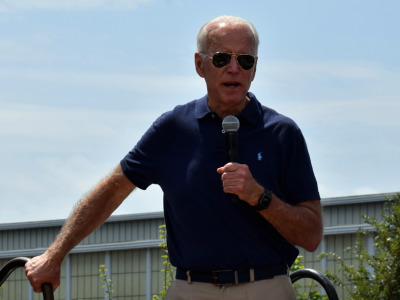President Donald Trump and former Vice President Joe Biden both promise to increase usage of biofuels, but Trump is focused on expanding the market for conventional ethanol while Biden is prioritizing next-generation products that align more closely with his climate goals.
In his administration's policy decisions and his campaign's promises, Trump has focused on increasing the sale of conventional biofuels by easing restrictions on their distribution and subsidizing blender pumps and other infrastructure needs.
In recent days, the Environmental Protection Agency has denied 54 retroactive refinery waivers to corn ethanol usage requirements, and Trump announced that his administration would allow gasoline retailers to distribute E15, gasoline that contains 15% ethanol, in conventional pumps pending state approval.
The Trump campaign also promotes the administration's Higher Blends Infrastructure Incentive Program, a plan to build out the corn ethanol industry by making available $100 million to eligible participants to help increase “the sales and use of higher blends of ethanol and biodiesel by expanding the infrastructure for renewable fuels,” according to USDA.

President Donald Trump
Meanwhile, the Biden campaign said in responding to an American Farm Bureau Federation survey that developing next-generation biofuels would be "a top priority" for his administration as part of a $400 billion clean energy program.
“The Biden-Harris Plan will invest in research to develop cellulosic biofuels in a manner that protects our soil and water and addresses the challenge of climate change, while turning grass, crop residues, and other biomass into fuel,” the campaign said. "Doubling down on these liquid fuels of the future will not only make value-added agriculture a key part of the solution to climate change — reducing emissions in planes, ships, and other forms of transportation — but will also create quality jobs across rural America."
Former Agriculture Secretary Tom Vilsack, who is advising the Biden campaign, also says Biden would adhere more closely to the RFS by limiting the issuance of refinery waivers. Vilsack also said he believes that a Democratic administration would have provided direct assistance this year to ethanol producers hurt by the plunge in gasoline demand during the COVID-19 pandemic; Agriculture Secretary Sonny Perdue said he can't provide payments to ethanol producers without authorization from Congress.
Sen. Chuck Grassley, R-Iowa, argues that Trump has given more attention to the RFS than Biden. “I think farmers know it's very important to him and I don’t hear Harris and Biden talking about the RFS and ethanol at all,” Grassley said.
Tristan Brown, an associate professor of energy resource economics at the State University of New York, said the buildout of E15 infrastructure and reduction of SRE award volumes will support demand for biofuels and especially ethanol. “Absent a higher market value for biofuels though, these changes are unlikely to be sufficient to increase biofuel usage by very much,” Brown told Agri-Pulse.
Retrofitting existing gasoline pumps to dispense E15 can cost up to $225,000 per station, and the COVID-19 pandemic also has slowed the transition to E15 by depressing gasoline demand, Brown said. Allowing conventional pumps to dispense E15, as Trump has called for, is designed to allow stations and convenience stores to avoid the retrofitting expense.
Trump has walked a fine line with the RFS in order to balance support from Midwest farmers as well as oil refiners in the battleground state of Pennsylvania. His administration has yet to announce RFS annual volume requirements and may not do so until after the election. This delay, along with the administration's previous granting of small refinery exemptions, is something Biden has tried to capitalize on throughout the campaign.
In late August, Biden blasted Trump for the delay in issuing the 2021 usage mandates. “The Renewable Fuel Standard marks our bond with our farmers and our commitment to a thriving rural economy,” Biden said.
The cellulosic fuel industry that Biden envisions developing is still in its infancy despite lucrative government incentives, including a $1.01-a-gallon tax credit, and decades of research.
Cellulosic fuels can be made from a variety of forms of plant cellulose, the material that makes up cell walls. The potential feedstocks, including wood chips, corn stalks, wheat straw and grasses, are plentiful and aren’t used for food. So, at the behest of environmental groups, the 2007 law that created the existing Renewable Fuel Standard envisioned building a market for cellulosic biofuels that would surpass the demand for conventional ethanol.
Interested in more coverage and insights? Receive a free month of Agri-Pulse.
The 2007 RFS called for refiners to quickly ramp up cellulosic biofuel usage from 100 million gallons in 2010 to 16 billion gallons by 2022. But in 2019, cellulosic biofuel production totaled only 434 million gallons, and 418 million gallons of that was in the form of renewable natural gas, a product often made from the methane emitted by landfills. The product is a substitute for natural gas in vehicles.
Brown said the relatively low price of gasoline since late 2014 has posed a major hurdle for cellulosic ethanol. “Cellulosic ethanol requires the wholesale price of gasoline to be higher than approximately $3 a gallon in order to be competitive,” Brown said.
The RFS and California's Low Carbon Fuel Standard "help to make up some of this difference, but they ultimately have not provided enough support to justify large-scale investment in cellulosic ethanol facilities,” he said.
Cellulosic ethanol also has had to compete with cheaper corn ethanol for market share, although the rapid installation of E15 infrastructure in major gasoline markets could help to overcome that challenge, Brown said.

Former Vice President Joe Biden
House Agriculture Committee Chairman Collin Peterson told Agri-Pulse that he has urged the Biden campaign to maintain usage mandates for conventional ethanol.
“I’m not one of those out there advocating increasing conventional ethanol because I’m not foolish. I know what an uphill battle that would be, but I do want to maintain what we have, and I think we can live with that,” he said.
Vilsack also has called for building the market for next-generation fuels by requiring federal agencies to use them. The Obama administration used the Defense Department to demonstrate the use of renewable diesel and jet fuel, made from animal fats and other sources. "There are a multitude of ways in which fuels can be used," he said.
But Biden also plans to sharply increase electric vehicle use, which eventually takes away market share from conventional vehicles. His plan calls for the deployment of more than 500,000 new public charging stations across the country in the next 10 years.
Brown said electric vehicles present a mixed bag for the biofuels industry because they only replace gasoline-powered internal combustion engines and compete directly with fuel ethanol as a result.
“By reducing gasoline demand, (electric vehicles) also reduce the volume of ethanol consumption that can occur before the blend wall is encountered,” Brown said. “Refineries cannot run profitably without producing gasoline and many will shut down if EVs displace enough gasoline demand.”
However, he said demand for diesel fuel and jet fuel will remain high, so increased electric vehicle usage could result in less competition and higher market values for those biofuels that power heavy-duty transport vehicles.
For more news, go to www.Agri-Pulse.com.


